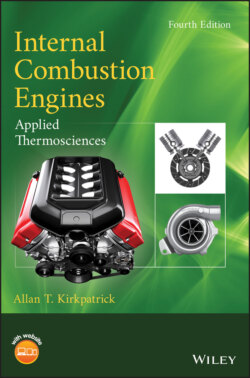Читать книгу Internal Combustion Engines - Allan T. Kirkpatrick - Страница 15
Spark‐Ignition Engine
ОглавлениеAs shown in Figure 1.4, the four‐stroke spark‐ignition engine has the following sequence of operations:
1 An intake stroke draws a combustible mixture of fuel and air past the throttle and the intake valve into the cylinder.
2 A compression stroke with the valves closed raises the temperature of the mixture. A spark ignites the mixture toward the end of the compression stroke.
3 An expansion or power stroke results from combustion of the fuel–air mixture.
4 An exhaust stroke pushes out the burned gases past the exhaust valve.
Air enters the engine through the intake manifold, a bundle of passages that evenly distribute the air mixture to individual cylinders. The fuel, typically gasoline, is mixed with the inlet air using a fuel injector or carburetor in the intake manifold, intake port, or directly injected into the cylinder, resulting in the cylinder filling with a homogeneous mixture. When the mixture is ignited by a spark, a turbulent flame develops and propagates through the mixture, raising the cylinder temperature and pressure. The flame is extinguished when it reaches the cylinder walls. If the initial pressure is too high, the compressed gases ahead of the flame will autoignite, causing a problem called knock. The occurrence of knock limits the maximum compression ratio and thus the efficiency of spark‐ignition engines. The burned gases exit the engine past the exhaust valves through the exhaust manifold. The exhaust manifold channels the exhaust from individual cylinders into a central exhaust pipe.
Figure 1.4 Four‐stroke spark‐ignition engine.
In the spark‐ignition cycle, a throttle is used to control the amount of air inducted. As the throttle is closed, the amount of air entering the cylinder is reduced, causing a proportional reduction in the cylinder pressure. Since the fuel flow is metered in proportion to the air flow, the throttle in a spark‐ignition engine, in essence, controls the power.
